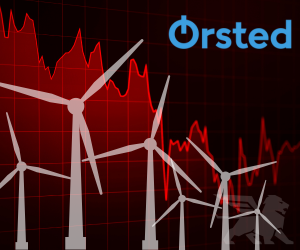ØRSTED STOCK COLLAPSE: WHAT HAPPENED IN 2025?
Ørsted A/S (ORSTED.CO), once Europe’s offshore wind crown jewel, has seen its share price collapse in 2025. Trading at just 117 DKK as of 9 November, it has fallen 64% year-to-date and nearly 68% over the past 12 months. The decline stems from a toxic combination of U.S. political opposition to renewables, major project write-downs, dilutive financing, and structural headwinds across the clean energy sector. While a £6.5 billion UK asset sale brought temporary relief, and shares briefly rallied post-Q3 earnings, the long-term picture remains grim. Once soaring at 778 DKK in early 2021, the stock has shed over 80% in five years, a stark reversal for the Danish wind leader. Analysts remain wary despite a derisked balance sheet, and Ørsted’s fair value estimate suggests it’s still trading at a premium — raising questions about its near-term upside.

Why Ørsted’s stock collapsed
Ørsted A/S, Denmark’s flagship renewable energy giant, has faced a brutal 2025, with shares plummeting nearly 64% since January. The underlying cause? A wave of setbacks, most notably U.S. policy headwinds under the Trump administration, which reversed pro-renewable trends and directly targeted offshore wind initiatives. Ørsted, heavily invested in American wind developments, found itself at the centre of this policy reversal. Multiple offshore projects were stalled or scrapped, triggering impairments and evaporating billions in projected revenue.
Beyond geopolitics, Ørsted’s operational challenges deepened investor concerns. The company reported weak wind outputs in Q3 2025, compounding already fragile sentiment. Earnings revealed a quarterly net loss, and management cited "broader renewable sector pressures" in a grim market update. Despite efforts to reassure investors — including highlighting a strengthened balance sheet — markets responded with skepticism. Even a modest post-earnings rally (1.2–1.9%) failed to reverse the broader downward spiral.
Dilution and project writedowns
In October 2025, Ørsted launched a major rights issue, raising 59.56 billion DKK (~$9.35 billion) to reinforce liquidity. While it was a strategic move, the issue was massively dilutive, further eroding investor value. The stock took another hit as analysts flagged long-term EPS compression and questioned Ørsted’s capital allocation strategy in hostile policy climates.
64% YTD drop due to U.S. policy pressure
Over 80% off its 2021 highs
Massive dilution via $9.35B rights issue
Q3 2025 net loss amid poor wind output
Ongoing market scepticism despite asset sales
Altogether, Ørsted’s downfall this year is a case study in how policy risk, execution failures, and misaligned capital moves can derail even the most respected green energy firms.
Steps taken to stabilise the business
Ørsted hasn’t been idle in the face of crisis. Amid political uncertainty and investor jitters, the company has made strategic moves to shore up its finances and protect its long-term viability. A key development was the sale of a 50% stake in the Hornsea 3 offshore wind project — a UK-based mega-asset — to Apollo-managed funds for $6.5 billion. This transaction, announced in early November 2025, helped inject liquidity into Ørsted’s books and demonstrated the underlying value of its European pipeline.
Meanwhile, management took the difficult but necessary step of announcing 2,000 job cuts in October. These cuts were part of broader cost optimisation tied to cancelled U.S. developments and slower deployment timelines. While painful, the restructuring is expected to result in long-term savings and operational efficiencies across its global footprint.
Capital, clarity and clean energy focus
Despite the stock rout, Ørsted’s leadership maintains a long-term vision rooted in clean energy dominance. The firm reiterated its 2040 net-zero target and remains committed to generating 95%+ of power from renewables by the end of 2025. These are lofty goals, but recent moves show a clearer path toward execution and resilience, especially across its European assets.
Hornsea 3 partial sale brought $6.5B cash
2,000 jobs cut for cost control
Balance sheet “derisked” via capital raises
Focus pivoting to EU wind markets
Reaffirmed 2040 net-zero target
In short, while Ørsted’s U.S. exposure remains a drag, the company is leaning into its strengths and stabilising its financial footing to weather policy storms.
Analyst outlook and stock forecast
As of early November 2025, analysts remain largely cautious on Ørsted’s outlook. While some see tactical upside from oversold conditions, the technical indicators still flash bearish. The stock trades near 117 DKK, a sharp fall from its 2021 peak of 778 DKK. Despite the recent uptick, Ørsted is trading roughly 66% above analysts’ fair value estimate of ~70.76 DKK, derived from a dividend discount model (DDM). That suggests potential downside unless earnings dramatically improve.
Strategically, Ørsted may benefit if European wind projects accelerate, particularly Hornsea 3, which is expected to come online over the next few years. However, U.S. headwinds — particularly the Trump administration’s continued hostility to offshore wind — remain the central overhang. Regulatory delays, suspended permits, and investor flight from the broader clean energy sector have created a challenging macro backdrop.
Mixed signals from the market
Some contrarian investors see value in Ørsted’s long-term fundamentals. Its commitment to net-zero, its world-class European wind portfolio, and its strategic resets may lay the groundwork for a turnaround — but only if policy and execution align. For now, volatility is likely to remain elevated, and earnings momentum is key to restoring confidence.
Shares trading at a 66% premium to fair value
Short-term technicals still show “sell”
Potential upside tied to EU wind ramp-up
U.S. policy remains key downside risk
Analyst sentiment remains mostly neutral-to-bearish
Bottom line: Ørsted has work to do. The next 6–12 months will likely determine whether 2025 marks a painful low or just the start of deeper restructuring.







